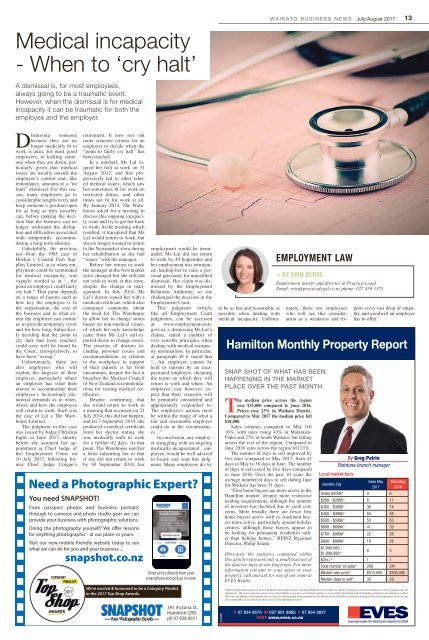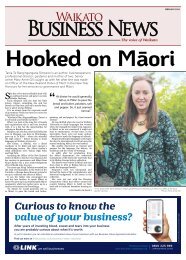Waikato Business News July/August 2017
Waikato Business News has for a quarter of a century been the voice of the region’s business community, a business community with a very real commitment to innovation and an ethos of co-operation.
Waikato Business News has for a quarter of a century been the
voice of the region’s business community, a business community
with a very real commitment to innovation and an ethos of
co-operation.
Create successful ePaper yourself
Turn your PDF publications into a flip-book with our unique Google optimized e-Paper software.
WAIKATO BUSINESS NEWS <strong>July</strong>/<strong>August</strong> <strong>2017</strong><br />
13<br />
Medical incapacity<br />
- When to ‘cry halt’<br />
A dismissal is, for most employees,<br />
always going to be a traumatic event.<br />
However, when the dismissal is for medical<br />
incapacity it can be traumatic for both the<br />
employee and the employer.<br />
Dismissing someone<br />
because they are no<br />
longer medically fit to<br />
work is akin, for most good<br />
employers, to kicking someone<br />
when they are down, particularly<br />
given that medical<br />
issues are usually outside the<br />
employee’s control and, like<br />
redundancy, amounts to a “no<br />
fault” dismissal. For this reason,<br />
many employers go to<br />
considerable lengths to try and<br />
keep someone’s position open<br />
for as long as they possibly<br />
can, before making the decision<br />
that the business can no<br />
longer withstand the disruption<br />
and difficulties associated<br />
with temporarily accommodating<br />
a long-term absence.<br />
Unhelpfully, the previous<br />
test from the 1985 case of<br />
Hoskin v Coastal Fish Supplies<br />
Limited, as to when employment<br />
could be terminated<br />
for medical incapacity, was<br />
vaguely worded as at “…the<br />
point an employer could fairly<br />
cry halt.” That point depends<br />
on a range of factors such as<br />
how key the employee is to<br />
the organisation, the size of<br />
the business and to what extent<br />
the employer can continue<br />
to provide temporary cover<br />
and for how long. Subjectively<br />
deciding that the point to<br />
cry halt had been reached,<br />
could very well be found by<br />
the Court, retrospectively, to<br />
have been “wrong.”<br />
Unfortunately, there are<br />
also employees who will<br />
exploit the largesse of their<br />
employer, particularly where<br />
an employer has tried their<br />
utmost to accommodate their<br />
employee’s increasingly dictatorial<br />
demands as to when,<br />
where and how the employee<br />
will return to work. Such was<br />
the case of Lal v The Warehouse<br />
Limited.<br />
The judgment in this case<br />
was issued by Judge Christina<br />
Inglis in June <strong>2017</strong>, shortly<br />
before she assumed her appointment<br />
as Chief Judge of<br />
the Employment Court on<br />
10 <strong>July</strong> <strong>2017</strong>, following former<br />
Chief Judge Colgan’s<br />
retirement. It now sets out<br />
more concrete criteria for an<br />
employer to decide when the<br />
“point to fairly cry halt” has<br />
been reached.<br />
In a nutshell, Ms Lal injured<br />
her foot at work on 31<br />
<strong>August</strong> 2012, and this progressively<br />
led to other related<br />
medical issues, which saw<br />
her sometimes fit for work on<br />
restricted duties, and other<br />
times not fit for work at all.<br />
By January 2014, The Warehouse<br />
asked for a meeting to<br />
discuss this ongoing incapacity<br />
issue and try to get her back<br />
to work. At the meeting which<br />
resulted, it transpired that Ms<br />
Lal would return to work, but<br />
she no longer wanted to return<br />
to the Newmarket store during<br />
her rehabilitation as she had<br />
“issues” with the manager.<br />
Before her return to work<br />
the manager at the Newmarket<br />
store changed but she still did<br />
not wish to work at this store,<br />
despite the change in management.<br />
In <strong>July</strong> 2014, Ms<br />
Lal’s doctor issued her with a<br />
medical certificate, which also<br />
contained comments about<br />
the need for The Warehouse<br />
to allow her to change stores<br />
based on non-medical issues,<br />
of which his only knowledge<br />
came from Ms Lal’s self-reported<br />
desire to change stores.<br />
The practise of doctors including<br />
personal issues and<br />
recommendations in relation<br />
to the workplace in support<br />
of their patient, is far from<br />
uncommon, despite the fact it<br />
breaches the Medical Council<br />
of New Zealand recommendations<br />
for issuing medical certificates.<br />
Despite confirming that<br />
she would return to work in<br />
a meeting that occurred on 21<br />
<strong>July</strong> 2014, this did not happen,<br />
and on 3 September 2014, she<br />
produced a medical certificate<br />
from her doctor stating she<br />
was medically unfit to work<br />
for a further 42 days. At that<br />
point, The Warehouse sent her<br />
a letter informing her to that<br />
if she did not return to work<br />
by 30 September 2014, her<br />
employment would be terminated.<br />
Ms Lal did not return<br />
to work by 30 September and<br />
her employment was terminated,<br />
leading her to raise a personal<br />
grievance for unjustified<br />
dismissal. Her claim was dismissed<br />
by the Employment<br />
Relations Authority, so she<br />
challenged the decision in the<br />
Employment Court.<br />
This judgment (which,<br />
like all Employment Court<br />
judgments, can be accessed<br />
at www.employmentcourt.<br />
govt.nz.), dismissing Ms Lal’s<br />
claims, stated a number of<br />
very sensible principles when<br />
dealing with medical incapacity<br />
terminations. In particular,<br />
at paragraph 48 it stated that<br />
“…An employer cannot be<br />
held to ransom by an incapacitated<br />
employee, dictating<br />
the terms on which they will<br />
return to work and where. An<br />
employee can however expect<br />
that their concerns will<br />
be genuinely considered and<br />
appropriately responded to.<br />
The employer's actions must<br />
be within the range of what a<br />
fair and reasonable employer<br />
could do in the circumstances…”<br />
In conclusion, any employer<br />
struggling with an ongoing<br />
medically-incapacitated employee,<br />
would be well advised<br />
to locate and read this judgment.<br />
Many employers do try<br />
Need a Photographic Expert?<br />
You need SNAPSHOT!<br />
From passport photos and business portraits<br />
through to cameras and photo studio gear we can<br />
provide your business with photographic solutions.<br />
Doing the photography yourself? We offer lessons<br />
for anything photographic - at our place or yours.<br />
Visit our new mobile friendly website today to see<br />
what we can do for you and your business ...<br />
snapshot.co.nz<br />
Order prints directly from your<br />
smartphone and pick up in-store<br />
We’re excited & honoured to be a Category Finalist<br />
in the <strong>2017</strong> Top Shop Awards.<br />
391 Victoria St,<br />
Hamilton CBD.<br />
ph 07 838 0031<br />
J9788P<br />
EMPLOYMENT LAW<br />
> BY ERIN BURKE<br />
Employment lawyer and director at Practica Legal<br />
Email: erin@practicalegal.co.nz phone: 027 459 3375<br />
to be as fair and reasonable as<br />
possible when dealing with<br />
medical incapacity. Unfortunately,<br />
there are employees<br />
who will see this consideration<br />
as a weakness and exploit<br />
every last drop of empathy<br />
and goodwill an employer<br />
has to offer.<br />
Hamilton Monthly Property Report<br />
SNAP SHOT OF WHAT HAS BEEN<br />
HAPPENING IN THE MARKET<br />
PLACE OVER THE PAST MONTH.<br />
The median price across the region<br />
rose $35,000 compared to June 2016.<br />
Prices rose 23% in <strong>Waikato</strong> District.<br />
Compared to May <strong>2017</strong> the median price fell<br />
$18,000.<br />
Sales volumes compared to May fell<br />
16%, with sales rising 43% in Matamata-<br />
Piako and 27% in South <strong>Waikato</strong>, but falling<br />
across the rest of the region. Compared to<br />
June 2016 sales across the region fell 21%.<br />
The number of days to sell improved by<br />
five days compared to May <strong>2017</strong>, from 41<br />
days in May to 36 days in June. The number<br />
of days to sell eased by five days compared<br />
to June 2016. Over the past 10 years the<br />
average number of days to sell during June<br />
for <strong>Waikato</strong> has been 51 days.<br />
“First home buyers are more active in the<br />
Hamilton market, despite more restrictive<br />
lending requirements, although the number<br />
of investors has declined due to yield concerns.<br />
More broadly there are fewer first<br />
home buyers active with ex-Auckland buyers<br />
more active, particularly around holiday<br />
centres, although these buyers appear to<br />
be looking for permanent residences rather<br />
than holiday homes.” REINZ Regional<br />
Director, Philip Searle.<br />
Obviously the statistics contained within<br />
this article represent only a small fraction of<br />
the data we have at our fingertips. For more<br />
information relevant to your street or your<br />
property, call and ask for one of our team at<br />
EVES Realty.<br />
P 07 834 9570 M 027 801 9962 F 07 854 3837<br />
VISIT www.eves.co.nz<br />
Hamilton City<br />
By Greg Petrin<br />
Rototuna branch manager<br />
Local market facts<br />
Sales May<br />
<strong>2017</strong><br />
Sales May<br />
2016<br />
Under $200k* 0 6<br />
$200 - $299k* 6 11<br />
$300 - $399k* 36 74<br />
$400 - $499k* 84 88<br />
$500 - $599k* 53 63<br />
$600 - $699k* 41 39<br />
$700 - $999k* 22 28<br />
$800 - $999k* 18 28<br />
$1,000,000 -<br />
$1,999,999*<br />
8 3<br />
$2m+* 1 1<br />
Total number of sales* 269 341<br />
Median sale price* $515,000 $485,000<br />
Median days to sell* 32 29<br />
*Statistical Information Derived From The Real Estate Institute Of New Zealand. Realty Services Ltd/Success Realty Ltd and any contractor/employee is merely passing over the<br />
information. We cannot guarantee its accuracy and reliability as we have not checked, audited or reviewed the information and all intending purchasers are advised to conduct<br />
their own due diligence investigation into the same. To the maximum extent permitted by law Realty Services Ltd/Success Realty Ltd and its contractors/employees do not accept<br />
any responsibility to any person for the accuracy of the information herein.


















